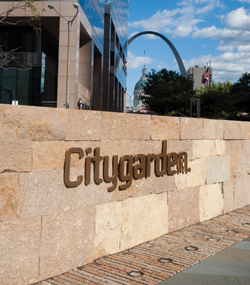Scene
Citygarden: An artistic oasis in downtown St. Louis

Citygarden is located downtown at the intersection of 8th and Market Streets. The park is close to the 8th and Pine MetroLink station and is within walking distance from the Gateway Arch. (Matt Aristide Mailol’s bronze sculture “La Riviere” sits in the upper level of Citygarden’s pool. (Matt Mitgang| Student Life)

Aristide Mailol’s bronze sculture “La Riviere” sits in the upper level of Citygarden’s pool. (Matt Mitgang| Student Life)
Correction Appended Below
Between the Arch and the Civil Courts Building, at the corner of 8th and Market Street, lies the newly opened Citygarden. Outstanding examples of public art are displayed throughout the two-square-block park, ranging from a looming bronze scarecrow in the vein of “Christ the Redeemer,” to an enormous bronze bust of the Greek god Eros, face wrapped in bandages and twisted into an expression of anguish. Citygarden’s repertoire is not limited to large bronze figures, however. A variety of different media, including several multimedia installations, litter the park. In addition, a café called The Terrace View, which serves fresh salads and light meals, is located at the edge of the area. One of the works actually inhabits the restaurant itself.
After opening on July 1, 2009, Citygarden became an immediate hit. “It was successful beyond our wildest dreams,” said Paul Wagman, spokesman for the Gateway Foundation. The foundation, responsible for the rabbit version of “The Thinker” on the Washington University campus, selected Citygarden’s art and currently manages the area. “It attracts a cross section of people,” Wagman said, referring to the large masses often seen in the park on sunny days. “We had no idea how many people it would draw, and the crowds have been really terrific.”
Walking around the park, one can easily see its draw. The garden is split into three sections designed to imitate St. Louis’ geography: The raised section represents the bluffs near the river, the middle of the park symbolizes the floodplains and the opposite side typifies a river terrace. Numerous pieces catch the viewer’s eye. “Zenit,” a statue of a horse with a stellated dodecahedron propped where a rider would normally be, stands at the edge of the park, watching over the entire garden. Giving off a sense of nobility and tranquility, “Zenit” (the brainchild of Italian sculptor Mimmo Paladino) almost appears to be the guardian figure of the park, ready to descend into it at a moment’s notice.
A bronze child-like rendering of Mister Geppetto, created by Tom Otterness, stands on a corner. Aptly titled “Kindly Geppetto,” this statue is reminiscent of The Pillsbury Doughboy, with its rotund torso, round head and relatively spindly arms and legs. Geppetto, holding a small puppet in one hand and a comically large hammer in the other, appears to be completing Pinocchio. The entire effect is rather humorous and sets an upbeat tone that continues throughout the park.
It bears noting that there is a complementary piece halfway through the garden, titled “Big White Gloves, Big Four Wheels.” It consists of an enormous sculpture of Pinocchio on a small wagon, arms thrown upward in an expression of almost religious ecstasy. Pinocchio appears to be almost human from far away, but upon closer inspection it is apparent that he is still a puppet: His arms and legs are squared off and block-like. Ironically, if Pinocchio’s statue were placed next to “Kindly Geppetto,” the puppet would tower over the designer in a sort of satirical reversal of their roles.
Unsurprisingly, children cluster around these busts. Another piece that appears to fascinate them is a series of bronze panels by Alfons Van Leggelo, called “Dance Chimes.” These nine rectangles, arranged to form a larger square, each emit a different ring when stepped on. Numerous schoolchildren take turns bouncing across, stepping on each individual tile in turn.
Interest in the garden is not limited to children, however. Many adults walk around the park, talking quietly, or merely sitting and enjoying the atmosphere.
One of the most popular pieces is a bronze rowboat entitled, “Voyage,” by Jean-Michel Folon. Folon appears to take inspiration from the Impressionist artistic movement, as both the ship and the man sitting in it are reminiscent of their style. The man is faceless and wears clothing often found in a variety of Impressionist paintings, while the boat, nondescript and floating on a calm body of water, is another common aspect of Impressionist artwork.
Of particular regard is a bronze statue titled “Bird,” by Laura Ford. It is easily the most surreal and disturbing piece is the entire park. At about two and a half to three feet high, its
transhuman form consists of the upper body of a bird and the spindly legs of a child. Further adding to the creepiness factor is its oversized beak, suggestive of a crow’s, which looks like it could tear apart a small child. The bronze brings to mind the movie “Pan’s Labyrinth,” with its phantasmagorical and disquieting imagery. The statue’s apparent crime against nature is simultaneously terrifying and exciting, as it makes the mind struggle to imagine just what could have been running through Ford’s mind that motivated her to produce such a creature.
Overall, Citygarden is an outstanding addition to downtown St. Louis. It combines a sculpture garden, full of examples of exceptional public art, with a friendly interactive environment. A break from the cars and buildings of its urban surroundings, the park offers an appreciated change of scenery that is definitely worth visiting.
Correction: For the Record
The headline in an earlier version of this article incorrectly identified the name of a new sculpture garden in St. Louis; it is Citygarden, not Citygardens. Also, an earlier version of the article misidentified the spokesman for the Gateway Foundation; he is Paul, not Carl, Wagman. Student Life regrets the error.
